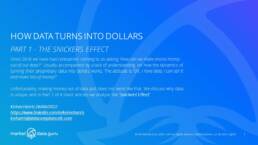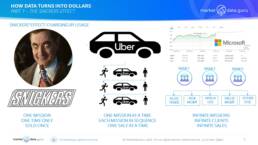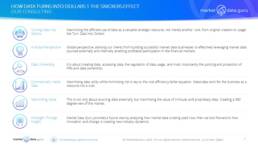
NEW TO THE DATA COMMERCIALISATION GAME?
Like it or not, as the information revolution really starts to build momentum, companies, organisations, individuals must realise they are all playing roles in the data game. This can be as producers (Sources), consumers, but most usually as both sources and consumers.
As the 202os progress we expect an increasing number of financial, trading, and commercial, companies to consider taking the data business route either to make money directly from commercialising their data, or indirectly by leveraging their data to help/lock-in clients into their workflows.
In the financial world realisation has already dawned that information, and data, is not only a powerful resource, it is a lucrative source of revenue both in its raw state and increasingly in even higher value added forms such as benchmarks (indices), and analytics which are able to predict behaviour by providing vital tools for business and investment decisions.
This realisation is spreading to other industries because new tech utilities like ‘The Cloud’ and ‘Big Data’ are opening doors to data to new opportunities.
QUESTIONS NOT ASKED
It seems strange as a concept, but the questions rarely asked are 1. ‘Why is making money out of data different to other commodities?’ And the natural progression 2. ‘How does data make money?’
I call the answer ‘The Snickers Effect’.
Note: The Mars Bar effect was coined by the Ashmore Group to describe Quantitative Easing, and The Kit Kat Effect was used by Nelson Mandela
SNICKERS’ EFFECT: IT IS ALL ABOUT UTILITY
The principle behind the ‘The Snickers Effect’ is simple. Data is all about generating revenue from perspective.
1. How many times can the same item can be used?
2. By how many different people?
3. For how many different purposes?
Data unlike other commodities can do all the above simultaneously.
In diagrammatic form, please see below, we can compare three different forms of sales usage case from single use (eating our Snickers) to infinite use by data. It is the way each of these commodities can be used that defines their utility, and from that the ability to charge for that commodity.

SNICKERS’ EFFECT: WHAT THIS MEANS WHEN CREATING REVENUE STREAMS
What the diagram tells us is that some commodities are 1. Single Usage only (our delicious Snickers bar) 2. Many can be put to use multiple times, but only in sequence by one user at a time and with 3. Data the same object can be used at the same time by different entities for multiple purposes.
What this means is the data source owner can charge (more correctly licence) the data consumer for each instance of usage. For a bank that uses specific data for risk management, that is one fee, for collateral management, there is a second fee, and if I want to distribute the data to third parties, or create new data from the original data such as indices, these require additional licence fees. A second bank using the same data is also charged accordingly, and so on, ad infinitum. Increasingly, commercial data models are gravitating towards usage principles.
CORONETS & CAVEATS
There are always caveats, firstly selling data for the sake of it will not work, it has to have value to someone. If someone is allergic to peanuts they are not going to buying a Snickers any time soon. Secondly a data business framework needs to be built, and in future articles we shall discuss this in more detail.
The positives outweigh the negatives, data can be the jewel in the crown of businesses helping drive clients to the underlying products that generate the data in the first place. Data is not always static, it changes as individual events happen, for instance as Microsoft stock trades it is dynamic, constantly updating. The data consumer then requires a continuous stream of up to date information on Microsoft’s share price, i.e. it is ‘sticky’ with low levels of volatility in the revenue stream.
Data businesses are highly profitable, are low cost to run (caveat-must invest to set up), as long as the ‘The Snickers Effect’ is understood.
Keiren Harris
29 June 2022
For a pdf copy please email: info@marketdata.guru.
For information on our consulting services please email:
knharris@datacompliancellc.com


